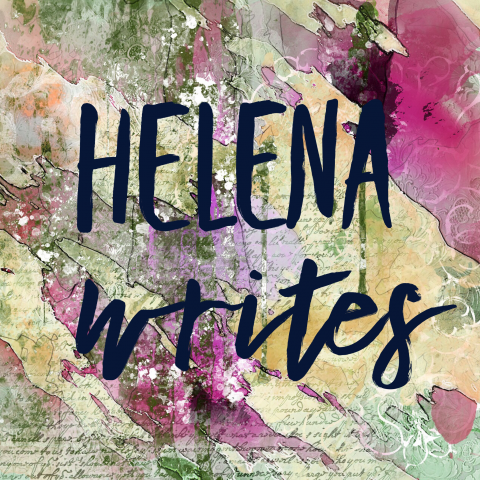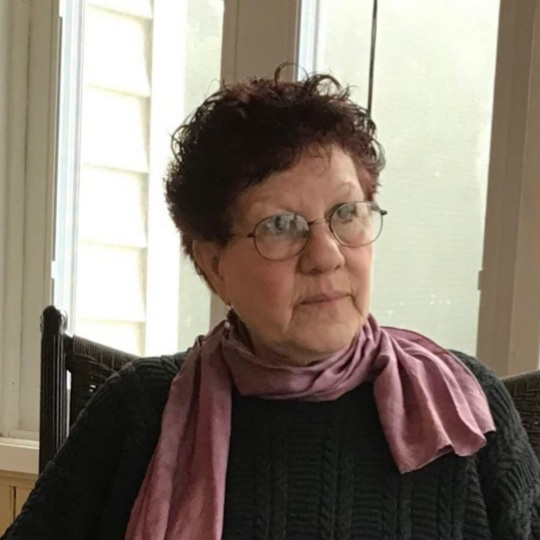
Helena Clare Pittman, one of the Center’s most dedicated teachers, has written, painted, and taught her entire life. In her monthly Helena Writes series, she shares a lifetime of wisdom, one pearl at a time.
In her 11th post, Helena considers how she became a teacher and learner, and how she continues to be both through her work with Center students, concluding with a lesson on voice. Enjoy!
Outside my studio window…
I begin so many things I write with those words—letters to friends and family, these blog writings. And there, today, my woods are in the infancy of spring.
Fine, crescent-shaped young leaves, yellow, on the witch hazel bushes, the scene looking lacy.
It’s raining, not snowing. My cat, Sebastian is resting next to me on my couch. Though the sky is a thick blanket of gray, the light is unmistakable. Spring light in a beech and maple woods. The yellow crescents pop, as my friend, Jean, a quilter, might say. I wondered for many years why that was, that yellow effect before rain. Back to Goethe’s formulation of luminosity: The capacity of colors to reflect light, relative to the spectrum. Using the measure of 12, yellow is 9. Orange is 8. Red is 6. So is green, red’s opposite. Blue is 4; Purple is 3. Nine is apparently much greater than 8. Orange doesn’t light up on a gray day, but yellow does.
From the time I was a young painter, I had a driving desire to understand color—to decipher what I was seeing. By teaching color, the door came open. That is the relationship of the individual to teaching. A process too mysterious to formulate, really; working with so many people groping their own way to understanding, to their internal core where a question burns sincerely, like yellow.
Yellow again. A primary color. Like gold, it can’t be reduced.
My color teacher, Mary Buckley, painted the chapel of angels at the Cathedral of St. John the Divine in Manhattan. Not surprising, the angels, I think now. Mary had stature, one of the teachers who lives in me. She offered me respect; I was a budding colorist, and she was in full bloom. One teacher is all it takes to chip away at one’s sense of nothing, nowhere, innocence of self.
And so I understand, with my sly secret, that yellow needs gray to reveal its great beauty. Run life by that metaphor.
I am exhausted from the daffodils I painted this month. Daffodil Exhaustion. But I have solved that years-in-process painting of last month’s post, and have a series of new paintings, one daffodil each. In them, yellow is revealed. This is akin to having written a story draft, one I can eventually submit to editors. Something of value has come into being. But I will have to ponder my paintings in the museum of my house, until I know where to show them.
Writing is easier, in that sense. A story is a calling card to submit to the world. Sending work to editors is a clear, well-traveled road. And one can submit multiples. No matter what “guidelines” may say.
Teaching
There is a photograph of my father, taken, I see now, by a professional photographer, to document and advertise the camp we spent our summers in. It was 1952 or 3. I was seven or eight. My father, born in 1903, 38 years after Lincoln walked the earth, when horses and carriages, wagons, buggies were the principal mode of transportation, was 49. He was on the growing edge of technology. He owned a Model T in the ’20s. In 1952, we had just acquired a new Dodge—forest green.
In this photo, my father looks a young man. It’s snapped in his Arts and Crafts shack. Boys Arts and Crafts, a wooden summer building, exposed boards and rafters, the smell of wood, weathered through freezes, summer rains, baking sun and baking ceramics. Plaster of Paris, turpentine, worked copper—sulphur to patina—then steel-wool the copper to brilliance. I can smell it now, of course. I reproduce something of this environment wherever I live and teach. The memory consoles like an old friend.
My father was leaning over a young camper who was sitting at a long-board table. His hands and the boy’s were woven together. He was helping the child press the copper into a mold. There was the rubber-wrapped, steel, spoon-shaped tool, and that set of four hands working the copper.
In the monumental sense, my father was a teacher. Helping others learn was his personal goal. His goal and another’s, a picture of union in those interwoven hands. The black and white film is beautiful. There was no alternative. It was color.
Teacher and learner, my father was my role model. In my family, teaching was a calling. I have a similar photo on my wall, a photocopy someone sent me, black and white, too. I’m helping a child tie up the spine of a picture book she’s made in a workshop I taught. I am just about my father’s age in the black and white from Camp Olympus. When I’m in that posture, I’m home. It’s a road, infinite, of bringing into existence something that has never been before. There I am, helping a child finish her book, my father’s daughter. Painting, writing, teaching, the road of vertical time. I worked for a time at CUNY, Queens College, where my father taught, too, though years before, in the classroom that might have been his. It was in the same building.
Memory in writing for children and memoir writing: A way to voice
A child has a capacity that is still available. She knows that vertical road of life, creating, voice. A sincere, good-faith calling, a question, an impetus to know, become, not yet confused by the message to conform. Memory is trustworthy; it carries feelings, preserved as if in amber. So I go to those floating scenes, those flash moments, to write. To find myself. In two photographs I have connected with my father and myself, I brought us together outside of time. I ask my students to do the same. That capacity is life-giving. It saves us. Let us write from our bedrock, our sincerity, without falsity, without manners. Then it can enter the reader’s good faith, and we save each other.
Learning
This year, I have learned two distinct things. One, I thought I knew, and I did. But it came home to me again, and I’m older now. It’s this: respect a student’s writing. Don’t jump in and impose my sense of writing. Listen.
“I wish you’d asked what it is I’m trying to say,” said my student to me a few months ago. I was stopped, awed. I apologized. She then told me what she meant, and we talked about it together. I was so grateful for that conversation.
Learning is a two-way street; or, to find my own words to say it: two people are greater than one. They form a community, a learning community into which wisdom can manifest for both.
I also learned this in the process of teaching memoir: Our lives seem to be in pieces, fragmented, fractured, damaged, and storm-tossed. How do I see it as one thing? A student asked me about it, point blank. And suddenly I knew the answer. I knew it because I could see it in her.
She was the constant. I am the constant. I am the knower who holds it all together. I am the unifier. I am the one who doesn’t change. The me-ness of me is the constant, from childhood to now.
And so it is a question of voice. Who is telling my story? I am. And I am greater than my experience. That was the realization that blew me away. I am greater than my experience, no matter how painful. My self is there, and can be recovered.
I’ll say it this way: I am the Artist of my life experience. The Crafter. The one who can weave whole cloth of threads, with all its colors. Through writing I have the capacity to find the master-work my life is.
Red 6
Orange 8
Yellow 9
Green 6
Blue 4
Violet 3
Grays and neutrals (make color visible)
How the color of me sings—in the end, how it sings!
Are you a teacher, a learner, or both? What part of Helena’s post most resonated with you? Share with us in the comments!
Related reading: Read the previous Helena Writes posts
Want to receive tips and inspiration like this in your inbox every Sunday morning? Join our email list community! You will receive weekly advice, a year’s worth of weekly writing prompts as a FREE download, and be eligible to participate in our monthly photo prompt contest for a chance to share an original piece of writing with our community of over 1,100 subscribers!
